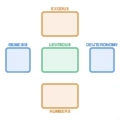Deuteronomy Book Map
Deuteronomy, the fifth book of the Torah, presents Moses' final addresses to Israel as they prepare to enter the Promised Land. The book is structured as a series of speeches that review the covenant relationship and restate the law for a new generation. Its 13 units form a cohesive pattern that completes the literary structure begun in Genesis and developed through the Torah.
The Structure of Deuteronomy
Deuteronomy reveals a sophisticated literary structure that complements and completes the Torah's overall design. The book mirrors Genesis in its use of triads, but with a crucial difference: while Genesis triads move from "above to below" (heavenly to earthly), Deuteronomy triads move from "below to above" (earthly to heavenly). This reversal creates a symmetrical "bookend" effect for the Torah.
Key Structural Elements:
- Four-Column Design: The 13 units are organized into four main columns, each representing a distinct thematic focus in Israel's covenant relationship with God.
- Inverted Orientation: Each vertical section moves from foundational (human-oriented) to transcendent (divine-oriented), the opposite progression from Genesis.
- Independent Unit: Unit 13 stands outside the regular pattern as a special culminating unit for both Deuteronomy and the entire Torah.
- Alternating Pattern: Units 1-6 alternate across columns A and B in a zigzag pattern before the more regular pattern in the second half of the book.
Column Themes:
The four columns of Deuteronomy's structure represent a logical progression in covenant relationship:
- Column A: Historical Narrative (Past) - Focuses on Israel's past experiences and historical foundations of the covenant relationship.
- Column B: Covenant Principles - Establishes the fundamental tenets of the relationship between God and Israel.
- Column C: Legal Corpus - Provides detailed instructions for implementing covenant principles in daily life.
- Column D: Covenant Future (Prophetic) - Projects forward to Israel's future, presenting both warnings and promises in prophetic perspective.
The oppositional relationship between Columns A and D creates a past-future axis that frames the book's theology. Column A looks backward to establish historical foundations, while Column D looks forward to describe future outcomes and possibilities.
Row Organization:
The three rows represent different levels of relationship between God and Israel, each with distinctive characteristics visible across all units in that row:
- Row 1: Foundational (Human-Oriented) - These units address Israel as a national, political entity with concrete historical experiences:
- Focus on visible manifestations of covenant relationship (journey, laws, blessings/curses)
- Emphasis on collective experience (the nation's history, communal worship, national prosperity or calamity)
- Addressed primarily to Israel as a political entity with leaders, boundaries, and social structures
- Concerned with external obedience to commandments and visible results
- Language tends to be historical and procedural with concrete descriptions
- Row 2: Mediating (Relational) - These units focus on the interpersonal dimension of covenant, bridging human and divine realms:
- Emphasis on covenant loyalty through love, fear, and devoted service
- Recognition of Moses' mediating role between God and people
- Integration of heart attitudes with outward actions (loving God while keeping commandments)
- Attention to family and community relationships as expressions of covenant fidelity
- Contains the Shema (6:4-9), the central theological statement of Deuteronomy
- Frequent use of relational language describing Israel's bond with God
- Row 3: Transcendent (Divine-Oriented) - These units elevate the covenant to its highest theological and spiritual dimension:
- Focus on divine attributes (God's faithfulness, justice, mercy, and sovereignty)
- Emphasis on covenant as relationship rather than merely legal obligation
- Contains the most theologically profound passages like Moses' intercession (9:25-29) and the Song of Moses (32:1-43)
- Exploration of divine election and God's unique relationship with Israel
- Addresses spiritual formation through remembrance and contemplation
- Language becomes more poetic and exalted, particularly in Unit 12
Connections to the Broader Torah Structure:
As the final book of the Torah, Deuteronomy completes patterns established in Genesis:
- Color Connection: The blue color scheme connects Deuteronomy with Genesis, highlighting their complementary themes of creation/cosmic order (Genesis) and political/social order (Deuteronomy).
- Structural Mirror: Deuteronomy's "below to above" orientation completes the movement begun in Genesis ("above to below"), creating a literary frame for the entire Torah.
- Independent Unit Sequence: Unit 13 connects with the independent units in Genesis (Unit 4) and Leviticus (Unit 13), forming a beginning-middle-end pattern across the horizontal thread of the Torah.
This sophisticated arrangement reveals Deuteronomy's role not simply as a collection of laws or speeches, but as a deliberately structured component of the Torah's complex literary design. It completes the patterns begun in Genesis and developed through the intervening books, forming a cohesive conclusion to the Torah as a whole.
↑ Back to Top